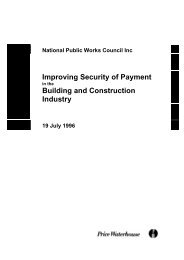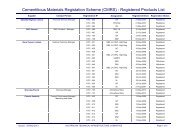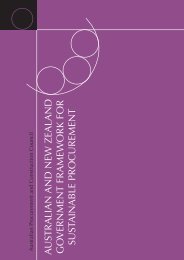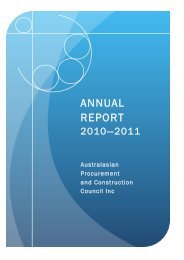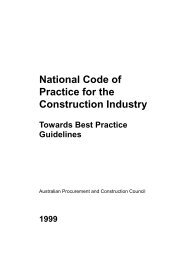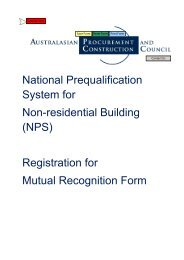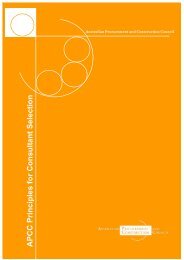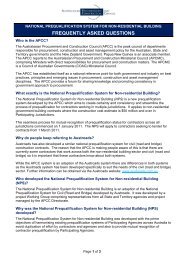ESD design guide for Australian Government buildings: Edition 2
ESD design guide for Australian Government buildings: Edition 2
ESD design guide for Australian Government buildings: Edition 2
You also want an ePaper? Increase the reach of your titles
YUMPU automatically turns print PDFs into web optimized ePapers that Google loves.
glossary<br />
glossary<br />
A<br />
ABGR<br />
ABGR is the universally accepted<br />
benchmarking tool <strong>for</strong> energy<br />
consumption of commercial <strong>buildings</strong> in<br />
Australia, and it has been incorporated<br />
in other rating systems to ensure a<br />
consistent approach from industry to this<br />
important issue. (DEUS, 2005).<br />
Adaptive Com<strong>for</strong>t<br />
Adds Human behaviour to the com<strong>for</strong>t<br />
analysis. It assumes that, if changes<br />
occur in the thermal environment to<br />
produce discom<strong>for</strong>t, then people will<br />
generally change their behaviour and act<br />
in a way that will restore their com<strong>for</strong>t.<br />
Such actions could include taking off<br />
clothing, reducing activity levels or even<br />
opening a window. The main effect of<br />
such models is to increase the range of<br />
conditions that <strong>design</strong>ers can consider<br />
as com<strong>for</strong>table, especially in naturally<br />
ventilated <strong>buildings</strong> where the occupants<br />
have a greater degree of control over<br />
their thermal environment. (Andrew Marsh<br />
Square one - http://www.squ1.com).<br />
Adhesives<br />
A substance capable of holding materials<br />
together by surface attachment.<br />
Adhesives are one source of off-gassing in<br />
indoor environments. (Property Council of<br />
Australia, Sustainable Development Guide,<br />
2001).<br />
AGO<br />
<strong>Australian</strong> Greenhouse Office, now part of<br />
the <strong>Australian</strong> <strong>Government</strong>’s Department<br />
of the Environment and Heritage.<br />
Air quality<br />
To do with the level of particulate, gases,<br />
vapours, pollens and micro-organisms<br />
in the air. (Property Council of Australia,<br />
Sustainable Development Guide, 2001).<br />
Alliance partnerships<br />
A long-term commercial partnering<br />
arrangement that enhances project<br />
team innovation and avoids the cost of<br />
tendering <strong>for</strong> team <strong>for</strong>mation on every<br />
new project. This can assist integrated<br />
delivery of sustainable <strong>design</strong> objectives.<br />
(Property Council of Australia, Sustainable<br />
Development Guide, 2001).<br />
Aquifer<br />
A geological <strong>for</strong>mation that will yield water<br />
to a well in sufficient quantities to make<br />
the production of water from this <strong>for</strong>mation<br />
feasible <strong>for</strong> beneficial use; permeable<br />
layers of underground rock or sand that<br />
hold or transmit groundwater below the<br />
water table. (Property Council of Australia,<br />
Sustainable Development Guide, 2001).<br />
B<br />
Base Building Brief<br />
Working document which specifies at<br />
any point in time the relevant needs and<br />
aims, resources of the client and user, the<br />
context of the project and any appropriate<br />
<strong>design</strong> requirements within which all<br />
subsequent briefing (when needed) and<br />
<strong>design</strong>ing can take place. (Adapted from<br />
definition of brief in ISO 9699).<br />
BDP<br />
<strong>Australian</strong> Council of Building Design<br />
Professionals – BPD has published<br />
a multi-volume Environment Design<br />
Guide containing literature on how to<br />
reduce environmental impact of the built<br />
environment. (Melbourne Docklands <strong>ESD</strong><br />
Guide, Oct 2002).<br />
BCA<br />
Building Code of Australia.<br />
Biodegradable<br />
A material capable of being decomposed<br />
by bacteria or other living organisms as<br />
a result of the action of micro-organisms.<br />
(Property Council of Australia, Sustainable<br />
Development Guide, 2001).<br />
Biodiversity<br />
The variety of all life <strong>for</strong>ms; the different<br />
plants, animals and micro-organisms, the<br />
genes they contain and the ecosystems<br />
they <strong>for</strong>m. (Property Council of Australia,<br />
Sustainable Development Guide, 2001).<br />
Brownfield Site<br />
Land within an urban area on which<br />
development has previously taken place.<br />
(Corus Construction Centre glossary,<br />
http://www.corusconstruction.com/page_<br />
9041.htm).<br />
Building monitoring systems or<br />
Building Management System (BMS)<br />
Also referred to at times as the Building<br />
Management System. A Building<br />
Management System includes more of<br />
the systems and plans <strong>for</strong> review and<br />
improvement while the Building Monitoring<br />
System is a computerised system that<br />
monitors the engineering services, security<br />
and other building systems <strong>for</strong> the purpose<br />
of recording, reporting and operational<br />
control of the systems to maximize safety,<br />
security, operational per<strong>for</strong>mance and <strong>for</strong><br />
overall cost minimization and efficiency.<br />
(Property Council of Australia, Sustainable<br />
Development Guide, 2001).<br />
C<br />
Carbon credit<br />
A term that refers to three types of units of<br />
greenhouse gas reductions defined under<br />
the Kyoto Protocol:<br />
• emissions reduction units are<br />
generated via joint implementation<br />
under Article 6 of the Kyoto Protocol,<br />
• certified emission reduction units are<br />
generated and certified under the<br />
provisions of Article 12 of the Kyoto<br />
Protocol, the Clean Development<br />
Mechanism, and<br />
• verified emission reductions are<br />
verified reductions in greenhouse gas<br />
emissions below a pre-determined<br />
baseline.<br />
(Property Council of Australia, Sustainable<br />
Development Guide, 2001).<br />
Carbon dioxide equivalent gases<br />
Greenhouse gases that contribute to<br />
the greenhouse effect are referred to as<br />
carbon dioxide equivalent gases since this<br />
is the most abundant greenhouse gas.<br />
(Property Council of Australia, Sustainable<br />
Development Guide, 2001).<br />
Chlorofluorocarbons (CFCs)<br />
Synthetic products which do not occur<br />
naturally and contain chlorine and fluorine;<br />
commonly used in various industrial<br />
processes and as refrigerants and, prior<br />
to 1990, as a propellant gas <strong>for</strong> sprays.<br />
CFCs are a powerful greenhouse gas.<br />
(Property Council of Australia, Sustainable<br />
Development Guide, 2001).<br />
CFCs are used as a refrigerant. They are<br />
the worst ozone depleting product and<br />
the most significant cause of ozone layer<br />
depletion. CFCs are being phased out as<br />
part of the Montreal Protocol. (Melbourne<br />
Docklands <strong>ESD</strong> Guide, Oct 2002).<br />
Client brief<br />
A project vision statement and sustainable<br />
development criteria provided to the<br />
<strong>design</strong> team. (Property Council of<br />
Australia, Sustainable Development Guide,<br />
2001).<br />
Climate Change Levy<br />
A tax on corporate energy use introduced<br />
by the government in 1999 aimed at<br />
reducing energy consumption. (Corus<br />
Construction Centre glossary, http://www.<br />
corusconstruction.com/page_9041.htm).<br />
Cogeneration<br />
Generation of electricity combined with<br />
the production of heat <strong>for</strong> commercial or<br />
industrial use. Excess electricity produced<br />
can be fed back into the power grid.<br />
Cogeneration is an energy efficient way of<br />
using fossil fuels. (National Greenhouse<br />
Strategy http://ngs.greenhouse.gov.<br />
au/glossary/).<br />
062<br />
<strong>ESD</strong> DESIGN GUIDE FOR AUSTRALIAN GOVERNMENT BUILDINGS


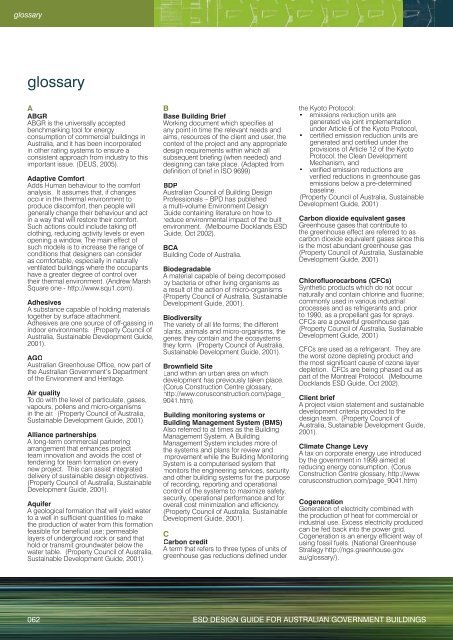
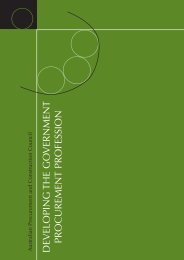
![NATIONAL COST ADJUSTMENT PROVISION EDITION 2 [NCAP2]](https://img.yumpu.com/48266135/1/184x260/national-cost-adjustment-provision-edition-2-ncap2.jpg?quality=85)
